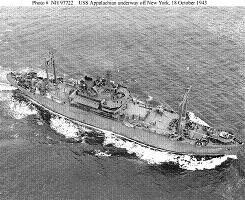![]() The Pacific War Online Encyclopedia
The Pacific War Online Encyclopedia
|
| Previous: Amphibious Assault | Table of Contents | Next: Amur River |

Naval Historical Center # NH 97722
Amphibious assaults against a strongly defended shoreline required superb command, control and communications (C3) to ensure success. During the early Allied amphibious assaults in the Pacific, it was common for the invasion commander to choose a battleship or other large man-of-war as his flagship. Unfortunately, the flagship was also supposed to participate in the pre-invasion bombardment, and it was found that the first salvo often disabled the battleship’s own radio communications gear from the shock of firing the guns. This left only signal flags and blinkers for communication, a slow way to go.
However, Admiral Turner used a troop transport, the McCawley, as his flagship for the Guadalcanal invasion, rather than one of the heavy cruisers in support. As a result, the supporting warships were able to lay down a heavy bombardment on Tulagi without interfering with Turner’s C3. This idea was formalized later in the war with the development of amphibious command ships, many of which were purpose-built for the role (as the Appalachian class.) These ships carried extensive communications equipment but only point-defense weapons, and proved invaluable in their role as the nerve center of an invasion.
It was fortunate for the Allies that the Japanese apparently never caught on, since the loss of the vulnerable command ship could have been disastrous for an invasion operation.
References
The Pacific War Online Encyclopedia © 2007, 2011 by Kent G. Budge. Index